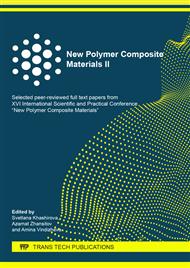[1]
E.M. Petrie, Handbook of adhesives and sealants, (2005).
Google Scholar
[2]
E.M. Petrie, Reactive hot-melt adhesives for better structural bonding, Met. Finish. 106 (2008) 39-43.
DOI: 10.1016/s0026-0576(08)80125-0
Google Scholar
[3]
I.A. Starostina, at al., Application of the acid-base approach to explain adhesive properties of modified rubber coatings, Polym. Sci. Ser. D. 5 (2012) 89-91.
DOI: 10.1134/s1995421212020141
Google Scholar
[4]
M.S. Perova, A.M. Makasheva, Y.N. Khakimullin, Influence of Maleic Anydrate on Properties of Incongealable Sealants based on Butyl Rubber, Polym. Sci. Ser. D. 4 (2011) 125-128.
DOI: 10.1134/s1995421211020122
Google Scholar
[5]
M.S. Perova, at al., Influence of the Molecular Weight of Oligoisobutylenes on the Properties of Uncured Sealants, Int. Polym. Sci. Technol. 38 (2011) 9-11.
Google Scholar
[6]
M.S. Perova, at al., Sealing compositions based on butyl rubber modified by reactive oligomers. Polym. Sci. Ser. D. 5 (2012) 26-29.
DOI: 10.1134/s1995421212010133
Google Scholar
[7]
M.S. Lisanevich, at al., Hot-Melt Sealants of Curable Type Based on Butyl Rubber and Ethylene-Vinyl Acetate Copolymer, Polym. Sci. Ser. D. 11 (2018) 359-362.
DOI: 10.1134/s1995421218040135
Google Scholar
[8]
L.Y. Zakirova, S.I. Vol'Fson, Y.N. Khakimullin, Determination of the surface free energy of thermoelastoplastic-modified bitumen, Polym. Sci. Ser. 49 (2007) 149-151.
DOI: 10.1134/s1811238207020105
Google Scholar
[9]
A.R. Akhmedgoraeva, at al., The Influence of Thickness and Reinforcement on the Properties of Sealing Tapes of Incongealable Type on the Basis of Butyl Rubber Depending on the Nature of the Glued Substrate, Polym. Sci. Ser. D. 12 (2019) 137-141.
DOI: 10.1134/s1995421219020035
Google Scholar
[10]
L.I. Murtazina, at al., The influence of calcium carbonate on the properties of noncuring sealants based on ethylene propylene diene monomer rubber and thermoplastics, Polym. Sci. Ser. D. 8 (2015) 199-202.
DOI: 10.1134/s1995421215030090
Google Scholar
[11]
R.Y. Galimzyanova, M.S. Lisanevich, Y.N. Khakimullin, Effect of calcium carbonate on the properties of noncuring sealants based on butyl rubber and thermoplastics, Russ. J. Appl. Chem. 86 (2013) 1287-1291.
DOI: 10.1134/s1070427213080223
Google Scholar
[12]
I. Lindström, at al., Occupational asthma and rhinitis caused by cyanoacrylate-based eyelash extension glues, Occup. Med. (Chic. Ill). 63 (2013) 294-297.
DOI: 10.1093/occmed/kqt020
Google Scholar
[13]
G.A. Koffuor, at al., Ocular discomforts following eyelash extension, J. Med. Biomed. Sci. 1 (2012) 55-61.
Google Scholar
[14]
E.R. Abah, at al., Eyelash extension use among female students in a Tertiary Institution in Nigeria: A study of kaduna polytechnic, Kaduna, Niger. J. Clin. Pract. 20 (2017) 1639-1643.
Google Scholar
[15]
B. Miljanović, at al., Impact of Dry Eye Syndrome on Vision-Related Quality of Life, Am. J. Ophthalmol. (2007) 409-415.
Google Scholar
[16]
D.A. Schaumberg, at al., Prevalence of dry eye syndrome among US women, Am. J. Ophthalmol. 136 (2003) 318-326.
Google Scholar
[17]
S.E. Moss, R. Klein, B.E.K. Klein, Prevalance of and risk factors for dry eye syndrome, Arch. Ophthalmol. 118 (2000) 1264-1268.
Google Scholar
[18]
W.K.S. Moore, A. Royce, Occupational Dermatitis Caused by Ethylene Oxide, Br. J. Ind. Med. 2 (1955) 169-171.
Google Scholar
[19]
S. Aumond, E. Bitton, The eyelash follicle features and anomalies: A review, J. Optom. Spanish General Council of Optometry. 11 (2018) 211-222.
DOI: 10.1016/j.optom.2018.05.003
Google Scholar
[20]
US 1831801. Method for the artificial elongation of eyelashes, (1931).
Google Scholar
[21]
US 3833007. Artificial eyelashes, (1974).
Google Scholar


